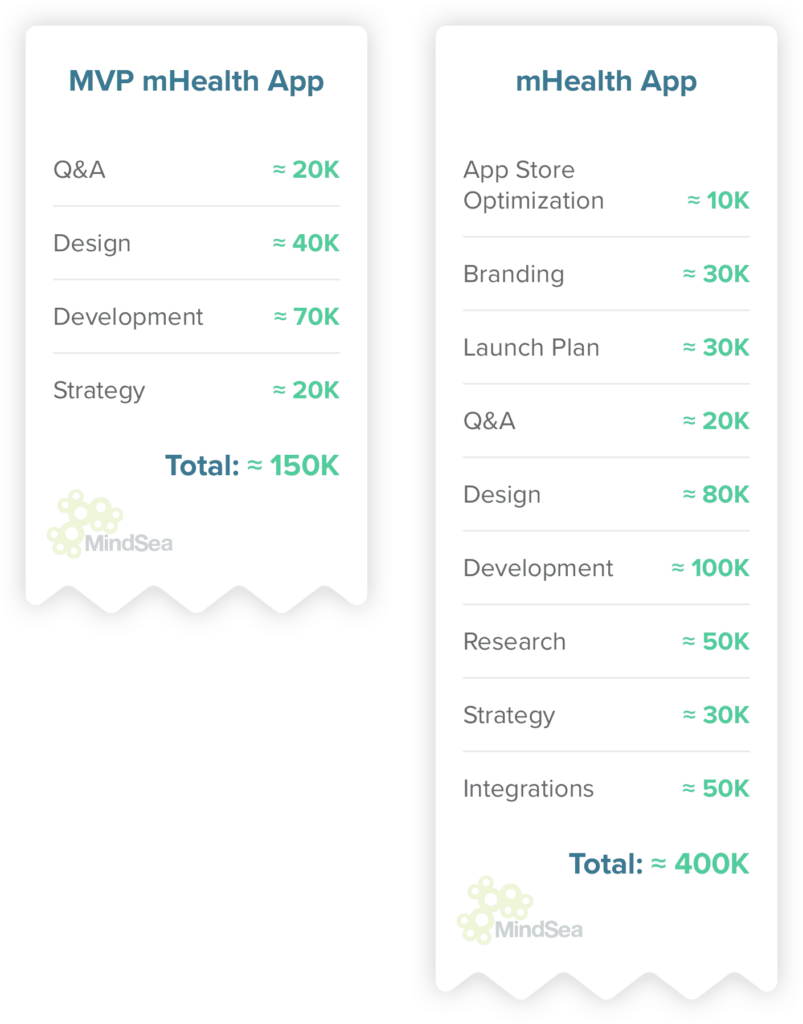A report published by Researchandmarkets.com states that the global mobile health (mHealth) app market “is expected to reach US$102.35 billion by 2023, growing at a CAGR of 29.30% during the period.”
These numbers not only speak volumes about the consistent innovation in this space but also clearly indicate that users are adopting mHealth apps. The opportunities are huge in this sector—there’s no denying it—so it’s not surprising that so many companies today want to grab a slice of the pie.
What kind of opportunities are out there? This chart shows the patient journey and a wide range of digital health use categories:

The chart presents a snapshot of the many opportunities for companies to create something amazing in this space. With today’s innovations in both healthcare and mobile technology, we can meet the needs of people with all kinds of health-related problems and goals. So why wouldn’t we?
Well, it’s not so simple. One issue facing mHealth app creators is, of course, money. How much does it cost to build an mHealth app?
Unfortunately, there isn’t a straightforward answer to this question. To understand the full cost of building an mHealth app (or any app for that matter), you need to break down the individual components that will impact the bottom line.
The cost of building an app can be broken out by stages:
- Pre-Build – How much does it cost to research and plan the app?
- Development – How much does it cost to build the app?
- Post-Development – How much does it cost to market and maintain the app?
Let’s analyze the factors that affect cost at each of these three stages:
Have You Completed Your Pre-Build Requirements?
Maybe you have a brilliant mHealth app idea. You know it will sell, but if you really want it to stand out from competitors (and rack up downloads) you need to have a clear app development strategy—something that all winning mobile apps have in common.
When apps are well-planned and strategically developed, every detail of design, development and deployment are aligned.
A clear strategy ensures that you are aware of the expenses at each stage of your build so that you don’t end up wasting precious resources. That said, the pre-build planning itself comes at a cost.
There are two major factors that influence the cost at the pre-build stage:
- App Design – The process of moving from sketches to wireframes to prototypes requires perhaps the largest investment of time and resources.
- User Research & Testing – User research plays a key role in how the app will be built. Without proper research, you won’t know what your users want or how the app will solve their problem. Doing the necessary groundwork by testing your riskiest assumptions before shelling out resources can save you a lot of time, money and heartache. The costs to be accounted for in user testing are the tools/software you use, the time spent finding subjects and conducting the research, and any incentives you want to provide.
The Cost Of Building Your mHealth App
Once you’ve got a strategy and a design in hand, it’s time to start building. What costs will come into play?
When budgeting for the development stage, you need to consider factors like:
- App Features – The cost of an mHealth app with complex functionality and tons of features will be drastically higher than the cost of a basic app with minimal features. That’s one reason it’s important to gauge whether people have any interest in the function or feature before adding all the bells and whistles to your app.
- Development Platform – The platform you choose will impact the cost of the app. For example, building an app for iOS is cheaper than building an app for Android, but you may have to invest more in quality assurance for iOS due to the platform’s stricter rules. And what if you want to launch on both platforms? Would you be shutting out a large chunk of your audience if you chose one platform over the other?
- Time To Market – What’s the timeline to build your app? Is it three months or 10 months? Time to market is directly tied to cost because, well, time is money! Be sure to factor in unexpected project delays—new releases and changes in third-party integrations are often known to extend timelines.
- In-House vs. Outsourced – This is an extremely crucial point when determining the cost of building an app. From a money perspective, there are tons of factors that favour building your app in-house, but it all boils down to expertise and team size. Smaller teams have a lot on their plate, and in most cases lack the budget, the time and the attention needed to deliver a great app. And while large teams may be able to afford such resources, or even hire for new internal roles, it’s still important to weigh your options.
- Regulations & Compliance – mHealth apps need to be HIPAA compliant. Skipping this step could lead to legal action and fines ranging anywhere from S100 to $50,000 depending on the severity and frequency of the lapse. Companies have to factor in the costs associated with being fully compliant, which is typically $10k and above.
Your App Is Live! Not So Fast…
Gaze into the future and think of the ways you’ll get people to download your mHealth app. What tactic will work best for grabbing your audience? Billboards, social media ads, influencer marketing…?
To ensure that people download your app, you’ll need to market it well. Of course, that too comes with a price tag that needs to be factored in early on, before you even get to this stage.
A final factor that companies should keep in mind is the ongoing maintenance associated with a mobile app. Frequent upgrades and bug fixes are essential for a good user experience, and those cost time and money.
Wrapping It Up
It wouldn’t be honest of us to give you a precise number for how much your particular health app will cost—because, as you can see, it greatly depends. But to ballpark it, your mHealth app could cost you anywhere between $150,000 and $400,000.

Besides the factors mentioned above, app development costs are also driven by geography, as reported by Statista.
It’s safe to say that mHealth apps are becoming increasingly prevalent and popular, and it’s exciting to see how companies are using mobile technology to help improve people’s lives.
We hope this post gives you a better idea of the various factors that will impact the final cost of your mHealth app. If you’ve got an idea for a new health app, there’s no better time to pursue it than now! All you need is a strategic partner to help you bring it to life.
Have we missed anything? Let us know in the comments below.



